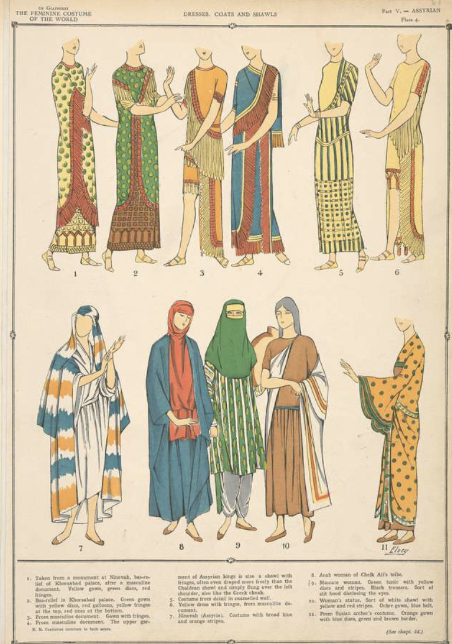





Mesopotamia, nestled between the two rivers of Tigris and Euphrates, is renowned for its influence on the human experience, notably in the realms of writing, law, and urbanisation. It was from Southern Mesopotamia that Cuneiform, the world’s first writing system, was developed. However, some of the most intriguing secrets of this civilisation lie in the development of textiles and costumes. The evolution of costumes in Mesopotamia mirrors the rise and progress of the civilisation. It also provides a lens through which we can see societal norms and cultural exchange of the ancient world.
Early Civilizations and Textile Innovations
The dawn of Mesopotamian civilisation brought about sophisticated textile craftsmanship. The Sumerians, who lived around 3000 B.C.E., laid the groundwork for the textile industry by transforming wool and goat hair into felt and woven cloth. The clothing from this era was characterised by its simplicity and functionality. Garments such as the kaunakes—a fleece skirt or cloak—embody the utilitarian approach to clothing designed to shield the wearer from the elements while facilitating everyday activities.
The baton of civilisation was passed to the Akkadians (2350–2218 B.C.E.), and they expanded the sartorial foundation laid by the Sumerians. The Akkadian period is marked by a continuity in textile practices, with further advancements in weaving techniques that allowed for more intricate designs and the introduction of more varied materials. As society developed, this period underscored the evolution from purely functional attire to garments that bore significance in social and religious contexts, reflecting the wearer’s status and role within society.
A style evolution led by ancient technology
The progression from Sumerian to Babylonian rule ushered in an era of unprecedented advances in textile technology and fashion. By 1894 B.C.E., Babylonians contributed to more than Mesopotamian law and culture. The sparse evidence available suggests that Babylonians potentially standardised textile trade regulations. The introduction of the loom and the refinement of weaving techniques facilitated the production of finer and more diverse fabrics in their application. The technological innovations of this period enhanced the quality of textiles, allowing Babylonians more artistic expressions. Linen, revered for its luxurious texture, became a staple for the garments of the elite, further embellished with gold appliqués and intricate beadwork, showcasing the Babylonians’ developing penchant for aesthetic sophistication.
The Role of Textiles in Assyrian Society
With the rise of the Assyrian Empire (1380–612 B.C.E.), Mesopotamian textiles witnessed further advancements, underpinning the empire’s economic and social structures. Assyrian textiles were renowned for their diversity and quality, serving as everyday clothing and playing pivotal roles in trade and diplomacy as symbols of status within the empire. The use of textiles in Assyrian society extended beyond practical applications to reflect the empire’s complex socio-political dynamics.
Assyrian advancements in textile techniques are reflected in the elaborate garments depicted in stone reliefs and artefacts from this period. The introduction of more varied styles, including embellishing garments with fringes, tiered designs, and vibrant dyes, showcased a blend of technological prowess and artistic innovation. This period also saw the introduction of luxurious fabrics, such as silk, which arrived through trade routes connecting Mesopotamia with distant civilisations such as China. These materials were not merely functional but were ingrained with social and cultural significance, often reserved for the elite and religious figures, emphasising the wearer’s status.
The Assyrian Empire’s textile economy was robust, with textiles as essential trade commodities and prestigious diplomatic gifts. Textiles were among the items exchanged in diplomatic missions, acting as symbols of goodwill and fostering alliances between Assyria and other states.
Persian Influences and Innovations
The conquests of the Persian Empire (550–330 B.C.E.) introduced a new chapter in the history of Mesopotamia. With their extensive trade networks and expanding empire, the Persians brought significant innovations in textile production and fashion. The introduction of cotton around 700 B.C.E. and later silk marked a substantial expansion of the Mesopotamian textile repertoire, reflecting the empire’s connections with South Asian and Chinese civilisations. These materials offered new textures and possibilities for garment design, further broadening Mesopotamian fashion.
Silk, in particular, symbolised the wealth and power of the elite. Its rarity and cost ensured that it was a material reserved for the highest echelons of society. Silk was often used in garments worn by royalty and high-ranking officials. The adoption of silk and finely woven cotton garments signified a shift in material preferences and indicated the Persian Empire’s vast trade networks and cultural influences. The Persians carried on the traditions of dyeing, embroidering and embellishing high-profile garments for the elites.
The integration of Persian styles into Mesopotamian attire, such as the adoption of trousers for both military and ceremonial use, reflected the cultural exchanges and fusion of traditions resulting from the Persian conquests. This period of Persian influence exemplifies the dynamic nature of Mesopotamian fashion, which evolved through interactions with neighbouring and faraway cultures throughout the millennia.
Gender and Class Distinctions in Mesopotamian Attire
The fabric of Mesopotamian society was mirrored in its array of costumes, which served as a visual lexicon of gender and class distinctions. Early Sumerian attire, with its waist strings and loincloths for men and shawls for women, laid the foundational differences between male and female dress. As civilisation progressed, these distinctions became more pronounced.
Men’s attire typically evolved from simple loincloths to more sophisticated kilts and tunics. Depending on a man’s social standing and occupation, his kilt’s length, material, and decoration could vary. On the other hand, women’s fashion ranged from shawls and simple tunics in the early periods to more elaborate dresses and veils often layered and embellished to denote marital status, social class, or religious affiliation .
The clergy had specialised clothing, and mourning attire was simpler but included embellishments and fringes. Archaeological evidence offers insight into the deeply intertwined nature of Mesopotamian culture’s fashion, spirituality, and social practices. These distinctions visually codified classes through clothing and showcased a complexly stratified society.
The legacy of ancient Mesopotamia still lives on in our daily lives, and it’s often hiding in plain sight. Jewellery and adornment are one aspect where we can still trace the influence of Mesopotamia, namely cylinder seals which are still used in designs to this day. Diane von Furstenberg may have popularised wrap dresses, but Mesopotamian clothing often consisted of wraparound garments secured with a belt or a sash. This style persists in various forms of traditional and modern dress worldwide, from the sarong and sari to Parisian haute couture.
For more on the traditional and historical dress of the Arab World, please sign up for the newsletter.